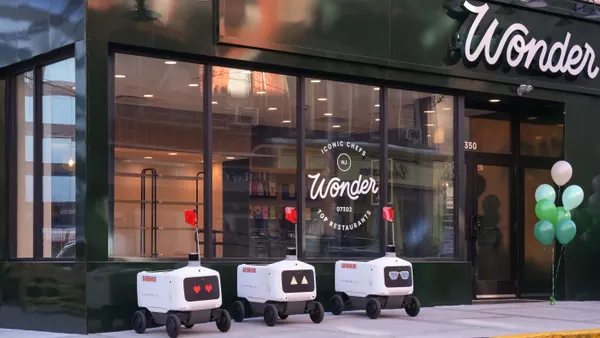Dive Brief:
- Wingstop's digital sales exceeded $1 billion in annual systemwide sales during 2020 representing 60% of the company's roughly $2 billion in total sales, CEO Charlie Morrison said during a Wednesday earnings call with investors. Comparatively, digital sales represented 39% of sales, or about $600 million, of systemwide sales during 2019, according to the company's 2019 earnings call.
- 2020 was Wingstop's first year introducing delivery across its system and has already grown to 25% of systemwide sales, Morrison said.
- Wingstop continues toward its goal of digitizing 100% of its transactions and is building upon its digital infrastructure, appointing a new chief technology officer in May and opening its first domestic kitchen in June.
Dive Insight:
When it comes to their digital operations, delivery, in particular, is becoming a greater growth opportunity for the company because guests using this channel are typically new to the brand, Wingstop Executive Vice President and CFO Michael Skipworth said during the call. It has also helped the company's digital database grow to include 20 million guests, which will help fuel the company’s CRM engagement efforts.
"Our personalized one-to-one marketing will play a bigger role to quickly generate repeat orders from the increasing number of new digital guests as well as continue to increase frequency amongst our core fans," Morrison said.
While Wingstop's digital customer database doesn't include those who made orders through DoorDash, the company's exclusive delivery partner, the company has the ability to understand who these guests are and how they shop, Morrison said. This allows the company to adapt how it markets to these customers, whether digitally or through national campaigns, he said. Delivery is also offered through Wingstop's website, but makes up about 40% of delivery transactions versus 60% coming through DoorDash, Morrison said. He added the company is agnostic as to where these transactions come from.
The company's ghost kitchens footprint now reaches 13 ghost kitchens across the globe, Morrison said. He noted the company is still in the early stages of understanding this economic model, but has plans to expand them in the U.S. in key markets.
Having a strong digital and delivery infrastructure in place has helped the brand compete with new players in the chicken wing space. Full-service brands like Applebee's and Chili's have entered the segment with virtual-only chicken wings brands. Morrison said additional competitors tend to impact the commodity prices of wings, which rise and fall with new competition, but said it has strong relationships with its suppliers, helping the company maintain supply.











